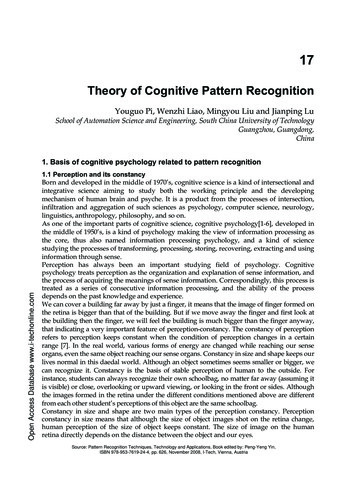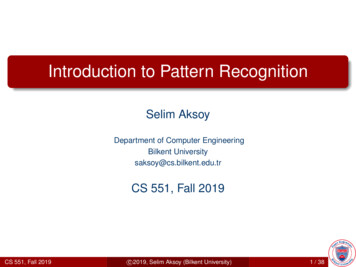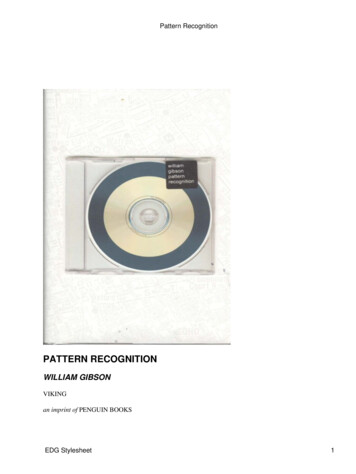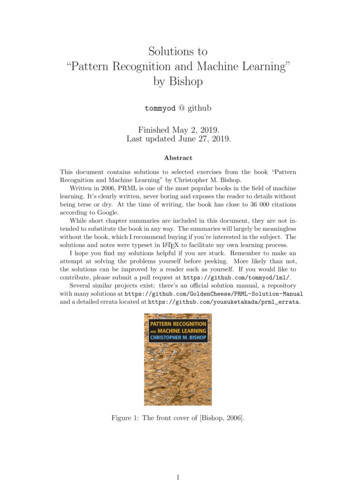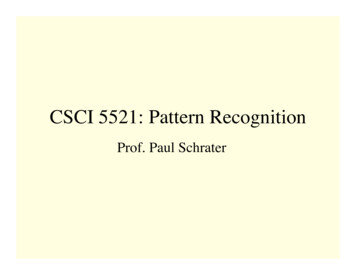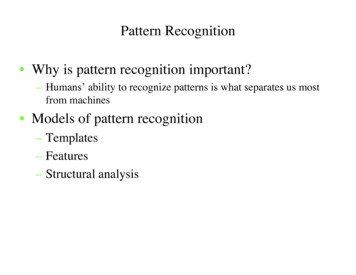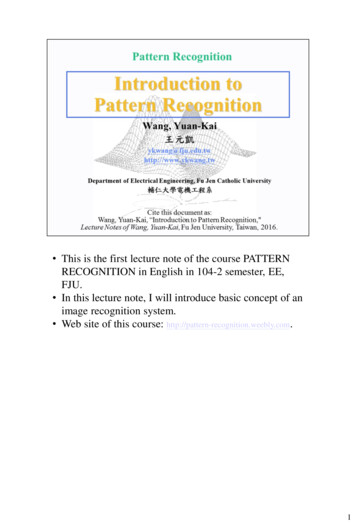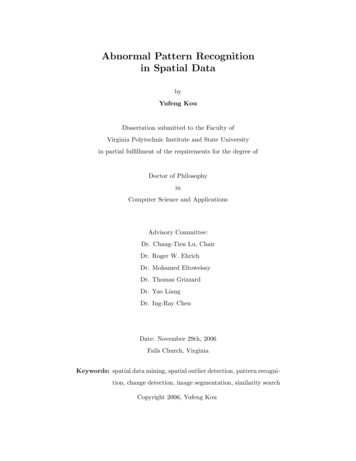
Transcription
Abnormal Pattern Recognitionin Spatial DatabyYufeng KouDissertation submitted to the Faculty ofVirginia Polytechnic Institute and State Universityin partial fulfillment of the requirements for the degree ofDoctor of PhilosophyinComputer Science and ApplicationsAdvisory Committee:Dr. Chang-Tien Lu, ChairDr. Roger W. EhrichDr. Mohamed EltoweissyDr. Thomas GrizzardDr. Yao LiangDr. Ing-Ray ChenDate: November 29th, 2006Falls Church, VirginiaKeywords: spatial data mining, spatial outlier detection, pattern recognition, change detection, image segmentation, similarity searchCopyright 2006, Yufeng Kou
Abnormal Pattern Recognition in Spatial DataYufeng KouAbstractIn the recent years, abnormal spatial pattern recognition has received a great deal of attentionfrom both industry and academia, and has become an important branch of data mining. Abnormal spatial patterns, or spatial outliers, are those observations whose characteristics are markedlydifferent from their spatial neighbors. The identification of spatial outliers can be used to revealhidden but valuable knowledge in many applications. For example, it can help locate extrememeteorological events such as tornadoes and hurricanes, identify aberrant genes or tumor cells,discover highway traffic congestion points, pinpoint military targets in satellite images, determinepossible locations of oil reservoirs, and detect water pollution incidents.Numerous traditional outlier detection methods have been developed, but they cannot be directly applied to spatial data in order to extract abnormal patterns. Traditional outlier detectionmainly focuses on “global comparison” and identifies deviations from the remainder of the entiredata set. In contrast, spatial outlier detection concentrates on discovering neighborhood instabilities that break the spatial continuity. In recent years, a number of techniques have been proposedfor spatial outlier detection. However, they have the following limitations. First, most of themfocus primarily on single-attribute outlier detection. Second, they may not accurately locate outliers when multiple outliers exist in a cluster and correlate with each other. Third, the existingalgorithms tend to abstract spatial objects as isolated points and do not consider their geometricaland topological properties, which may lead to inexact results.This dissertation reports a study of the problem of abnormal spatial pattern recognition, andproposes a suite of novel algorithms. Contributions include: (1) formal definitions of variousspatial outliers, including single-attribute outliers, multi-attribute outliers, and region outliers; (2)a set of algorithms for the accurate detection of single-attribute spatial outliers; (3) a systematicapproach to identifying and tracking region outliers in continuous meteorological data sequences; (4)a novel Mahalanobis-distance-based algorithm to detect outliers with multiple attributes; (5) a setof graph-based algorithms to identify point outliers and region outliers; and (6) extensive analysisof experiments on several spatial data sets (e.g., West Nile virus data and NOAA meteorologicaldata) to evaluate the effectiveness and efficiency of the proposed algorithms.
iiiACKNOWLEDGEMENTSFirst and foremost, I would like to thank my advisor, Dr. Chang-Tien Lu, for his support andguidance during my Ph.D. study. It is my great pleasure to be his first Ph.D. student. From Dr. Lu,I have learned advanced methodology to conduct rigorous research, strong sense of responsibilityto be a serious scientist, and firm persistence to seek the truth.I am very thankful to all the committee members. Without their guidance, I would neverhave been able to finish my dissertation. Thanks Dr. Grizzard for offering financial support formore than two years. Thanks Dr. Ehrich, Dr. Liang, and Dr. Eltoweissy for providing insightfulcomments and valuable suggestions from my proposal to final defense. Special thanks goes to Dr.Chen, who was willing to participate in my final defense committee at the last moment.I would also like to thank the kind help from my collaborators, Dr. Li Chen, Dr. Dechang Chen,Dr. Adil Godrej, and Dr. Lily Liang. Dr. Li Chen and Dr. Dechang Chen rendered tremendoushelp in building mathematic models and provided significant suggestions on experiment design.Dr. Godrej guided my OWML project on both software functionalities and user interface design.Dr. Liang offered summer support and introduced me to the interesting project of biological dataanalysis.I would like to express appreciation to my friends in the Spatial Data Management Laboratory,Jing Dai, Feng Chen, Ying Jin, Bing Liu, Arnold Boedijardjo, Edward Devilliers, Ray Dos Santos,Wendell Jordan-Brangman, Manu Shukla, and Chad Steel. Many thanks for their precious comments on my dissertation. Each discussion with them sparked new thoughts in my research. Theymade my Ph.D. study an enjoyable journey with a lot of happy memory.Finally, I would dedicate this dissertation to my parents and my elder brother. Without theirsupport, I could not have completed fundamental education in China, not mention to going abroadand pursuing advanced study in Virginia Tech.
ivContentsList of TablesviiList of Figures1Introduction1. . . . . . . . . . . . . . . . . . . . . . . . . .2. . . . . . . . . . . . . . . . . . . . . .41.2.1Spatial Data . . . . . . . . . . . . . . . . . . . . . . . . . . . . . . . . . . . .41.2.2Spatial Outlier Detection . . . . . . . . . . . . . . . . . . . . . . . . . . . . . .5. . . . . . . . . . . . . . . . . . . . . . . .101.1Traditional Outlier Detection Methods1.2Abnormal Pattern Recognition in Spatial Data1.32ixImage Segmentation and Wavelet Analysis1.3.1Image Segmentation . . . . . . . . . . . . . . . . . . . . . . . . . . . . . . . . 101.3.2Wavelet Analysis . . . . . . . . . . . . . . . . . . . . . . . . . . . . . . . . . . 12. . . . . . . . . . . . . . . . . . . . . . . . . . . . . . . . . . . . . . . .14. . . . . . . . . . . . . . . . . . . . . . . . . . . . .161.4Contributions1.5Organization of the DissertationSingle Attribute Outlier Detection2.12.2Spatial Outlier Detection17. . . . . . . . . . . . . . . . . . . . . . . . . . . . . . . . . .172.1.1Problem Formulation . . . . . . . . . . . . . . . . . . . . . . . . . . . . . . . . 172.1.2Deficiency of the Existing Approaches . . . . . . . . . . . . . . . . . . . . . . . 192.1.3Detection Algorithms . . . . . . . . . . . . . . . . . . . . . . . . . . . . . . . . 212.1.4Computational Complexity . . . . . . . . . . . . . . . . . . . . . . . . . . . . . 252.1.5Experiments. . . . . . . . . . . . . . . . . . . . . . . . . . . . . . . . . . . . 26Weighted Spatial Outlier Detection. . . . . . . . . . . . . . . . . . . . . . . . . . . .342.2.1Motivation . . . . . . . . . . . . . . . . . . . . . . . . . . . . . . . . . . . . . 342.2.2Problem Formulation . . . . . . . . . . . . . . . . . . . . . . . . . . . . . . . . 35
v2.333.25Algorithms . . . . . . . . . . . . . . . . . . . . . . . . . . . . . . . . . . . . . 362.2.4ExperimentsSummary. . . . . . . . . . . . . . . . . . . . . . . . . . . . . . . . . . . . 40. . . . . . . . . . . . . . . . . . . . . . . . . . . . . . . . . . . . . . . . . .Region Outlier and Change Detection3.142.2.3Region Outlier Detection. . . . . . . . . . . . . . . . . . . . . . . . . . . . . . . . . .47Problem and Approach . . . . . . . . . . . . . . . . . . . . . . . . . . . . . . . 483.1.2Algorithm Design . . . . . . . . . . . . . . . . . . . . . . . . . . . . . . . . . . 523.1.3Experiments3.1.4Discussion . . . . . . . . . . . . . . . . . . . . . . . . . . . . . . . . . . . . . . 71Change Detection. . . . . . . . . . . . . . . . . . . . . . . . . . . . . . . . . . . . 60. . . . . . . . . . . . . . . . . . . . . . . . . . . . . . . . . . . . .713.2.1Problem and Approach . . . . . . . . . . . . . . . . . . . . . . . . . . . . . . . 723.2.2Experimental Analysis . . . . . . . . . . . . . . . . . . . . . . . . . . . . . . . 753.2.3Summary . . . . . . . . . . . . . . . . . . . . . . . . . . . . . . . . . . . . . . 7682. . . . . . . . . . . . . . . . . . . . . . . . . . .82. . . . . . . . . . . . . . . . . . . . . . . . . . . . . . . . . . .83. . . . . . . . . . . . . . . . . . . . . . . . . . . . . . . .86. . . . . . . . . . . . . . . . . . . . . . . . . . . . . . . . . . . . . . . .874.1Motivation and Problem Formulation4.2Detection Algorithms4.3Computational Complexity4.4Experiments4.4.1Analysis of Census Data . . . . . . . . . . . . . . . . . . . . . . . . . . . . . . 874.4.2Analysis of West Nile Virus Data . . . . . . . . . . . . . . . . . . . . . . . . . 89Graph-based Outlier Detection94. . . . . . . . . . . . . . . . . . . . . . . . . . .94. . . . . . . . . . . . . . . . . . . . . . . . . . . . . . . . . . .975.1Motivation and Problem Formulation5.2Detection Algorithms5.4473.1.1Multiple Attribute Outlier Detection5.3455.2.1Algorithm 1: Point Outlier Detection . . . . . . . . . . . . . . . . . . . . . . . 1005.2.2Algorithm 2: Region Outlier Detection . . . . . . . . . . . . . . . . . . . . . . 1015.2.3Time Complexity . . . . . . . . . . . . . . . . . . . . . . . . . . . . . . . . . . 103Experiments. . . . . . . . . . . . . . . . . . . . . . . . . . . . . . . . . . . . . . . .1045.3.1Experiment Design . . . . . . . . . . . . . . . . . . . . . . . . . . . . . . . . . 1045.3.2Result Analysis . . . . . . . . . . . . . . . . . . . . . . . . . . . . . . . . . . . 104Summary. . . . . . . . . . . . . . . . . . . . . . . . . . . . . . . . . . . . . . . . . .107
vi6Conclusion and Future Work6.16.2Contributions. . . . . . . . . . . . . . . . . . . . . . . . . . . . . . . . . . . . . . . .1091096.1.1Single Attribute Outlier Detection . . . . . . . . . . . . . . . . . . . . . . . . . 1096.1.2Multi-attribute Outlier Detection . . . . . . . . . . . . . . . . . . . . . . . . . 1116.1.3Region Outlier Detection . . . . . . . . . . . . . . . . . . . . . . . . . . . . . . 1126.1.4Outlier Detection in Continuous Data Sequences . . . . . . . . . . . . . . . . . 1136.1.5Related Surveys and Demo Systems . . . . . . . . . . . . . . . . . . . . . . . . 113Future WorkBibliography. . . . . . . . . . . . . . . . . . . . . . . . . . . . . . . . . . . . . . . .113114
LIST OF TABLESviiList of Tables2.1Top three spatial outliers detected by z, iterative z, iterative r, median, scatterplot, andMoran scatterplot algorithms. . . . . . . . . . . . . . . . . . . . . . . . . . . . . . . . . 252.2The top five spatial outlier candidates detected by z, iterative z, iterative r, and medianalgorithms in Indiana. . . . . . . . . . . . . . . . . . . . . . . . . . . . . . . . . . . . . 272.3The top ten spatial outlier candidates detected by z, iterative z, iterative r, and Medianalgorithms. . . . . . . . . . . . . . . . . . . . . . . . . . . . . . . . . . . . . . . . . . . 302.4Top six spatial outlier candidates detected by z, iterative z, and median algorithms. . . 322.5The top 30 spatial outlier candidates detected by z, weighted z, and AvgDif f algorithms. 412.6The common border length, center distance, and weight of the 8 neighbors of York Co.(PA) . . . . . . . . . . . . . . . . . . . . . . . . . . . . . . . . . . . . . . . . . . . . . 432.7The common border length, center distance, and weight of the 4 neighbors of CamdenCo. (NJ) . . . . . . . . . . . . . . . . . . . . . . . . . . . . . . . . . . . . . . . . . . . 442.8The time complexity comparison between Median algorithm, Iterative-z, iterative-r,weighted z, and AvgDif f algorithms. . . . . . . . . . . . . . . . . . . . . . . . . . . . 463.1Scale Table for Mexican Hat Wavelet . . . . . . . . . . . . . . . . . . . . . . . . . . . 533.2Scale Table for Morlet Wavelet3.3The tracking data of hurricane center. . . . . . . . . . . . . . . . . . . . . . . . . . . . 643.4The execution time of image segmentation. . . . . . . . . . . . . . . . . . . . . . . . . 653.5Running time of K-Means. . . . . . . . . . . . . . . . . . . . . . . . . . . . . . . . . . 693.6Running time of Maximum Entropy. . . . . . . . . . . . . . . . . . . . . . . . . . . . . 703.7Running time of λ connectedness. . . . . . . . . . . . . . . . . . . . . . . . . . . . 704.1The top 10 spatial outlier candidates detected by the Mean algorithm and their associ-. . . . . . . . . . . . . . . . . . . . . . . . . . . . . . 54ated standardized attribute values . . . . . . . . . . . . . . . . . . . . . . . . . . . . . 88
LIST OF TABLES4.2viiiThe top 10 spatial outlier candidates detected by the Median algorithm and their associated standardized attribute values . . . . . . . . . . . . . . . . . . . . . . . . . . . . . 884.3Top 18 spatial outlier candidates, detected by the Median single-attribute algorithm,and their original/standardized attribute values. . . . . . . . . . . . . . . . . . . . . . . 914.4Top 162 spatial outlier candidates, detected by the multiple attribute algorithm, andtheir associated standardized attribute values. The rank is based on the magnitude ofthe Mahalanobis distance. . . . . . . . . . . . . . . . . . . . . . . . . . . . . . . . . . . 925.1Top three spatial outliers detected by scatterplot, Moran scatterplot, z-value, and graphbased method. . . . . . . . . . . . . . . . . . . . . . . . . . . . . . . . . . . . . . . . . 955.2Top 10 spatial outliers detected by z-value, scatterplot, Moran scatterplot, and graphpartition algorithms based on 1-bedroom rent. . . . . . . . . . . . . . . . . . . . . . . . 1055.32 region outliers detected by ROD Alg. based on two-bedroom rent data in 2005. . . . 1066.1The time complexity comparison between Median algorithm, Iterative-based algorithms,spatial weighted algorithms, and graph-based algorithms. . . . . . . . . . . . . . . . . . 111
LIST OF FIGURESixList of Figures1.1Tiling of time-frequency space by (a) Short time Fourier transformation, (b) Wavelettransformation . . . . . . . . . . . . . . . . . . . . . . . . . . . . . . . . . . . . . . . . 132.1A spatial data set. Objects are located in the X Y plane. The height of each verticalline segment represents the attribute value of the corresponding object. . . . . . . . . . 192.2Graphical illustration of the z algorithm. Data are shown in Figure 2.1. The height ofeach vertical line segment indicates the absolute value of the z-score. S1, E1, and E2would be identified as possible spatial outliers since their absolute z-score values are thelargest.2.3. . . . . . . . . . . . . . . . . . . . . . . . . . . . . . . . . . . . . . . . . . . 20Moran scatterplot used to detect the spatial outliers of the data in Figure 2.1. Here zscores represent the normalized attribute values. The three best candidates of outliersare S1, E1, and E2, located in the upper left and lower right quadrants. . . . . . . . . 212.4Scatterplot used to analyze the data in Figure 1. E1, E2, and S2 are the three bestspatial outlier candidates since their distances to the regression line are the largest. . . . 222.5Population Density of Marion Co., Shelby Co., Hancock Co., and their NeighboringCounties. . . . . . . . . . . . . . . . . . . . . . . . . . . . . . . . . . . . . . . . . . . . 272.6Population Density of Allen Co., St. Joseph Co, and their Neighboring Counties. . . . . 282.7Population Density of Tippecanoe Co., Vanderburgh Co., and their Neighboring Counties. 292.8US Population at the County Level in year 2001 . . . . . . . . . . . . . . . . . . . . . 292.9Cases of dead birds infected by WNV across all counties in the United States in 2002 . 312.10 Distribution of the values of attribute Bird-2002 in the vicinity of Allegheny, Bucks, andMontgomery. The numbers represent the values for Bird-2002. . . . . . . . . . . . . 332.11 Distribution of the values of attribute Bird-2002 in the vicinity of Berks, Lancaster, andWestmoreland. The numbers represent the values for Bird-2002. . . . . . . . . . . . . . 33
LIST OF FIGURESx2.12 Distribution of the values of attribute Bird-2002 in the vicinity of Dauphin and Armstrong. The numbers represent the values for Bird-2002. . . . . . . . . . . . . . . . . . 342.13 The 2003-Vet WNV case density for Hot Spring Co.(WY) and its neighbors. . . . . . 422.14 The 2003-Vet WNV case density for York Co.(PA) and its neighbors . . . . . . . . . . 432.15 The 2003-Vet WNV case density for Camden Co.(NJ) and its neighbors . . . . . . . . . 442.16 The 2003-Vet WNV case density for Anne Arundel Co. (MD) and its neighbors . . . . 453.1A regional outlier (hurricane) in meteorological data. . . . . . . . . . . . . . . . . . . . 493.2A sample output of the Mexican hat wavelet (a: original water vapor data, b: waveletpower at scale 2, c: wavelet power at scale 3).3.3. . . . . . . . . . . . . . . . . . . . . . 54A sample output of Morlet wavelet (a: original water vapor data, b: wavelet power atscale 6, c: wavelet power at scale 7). . . . . . . . . . . . . . . . . . . . . . . . . . . . . 553.4Global distribution of water vapor. . . . . . . . . . . . . . . . . . . . . . . . . . . . . . 623.5Mexican hat wavelet power with locations and scales (a: original and filtered data, b:wavelet for original data at all scales, c: wavelet for filtered data at all scales). . . . . . 633.6Wavelet power distribution at scale index 3. . . . . . . . . . . . . . . . . . . . . . . . . 643.7Reconstruction on both X Y dimension. . . . . . . . . . . . . . . . . . . . . . . . . . . 653.8Water vapor data at 0AM Sept. 18th, 2003 with Hurricane Isabel identified. . . . . . . 663.9Water vapor data at 6AM Sept. 18th, 2003 with Hurricane Isabel identified. . . . . . . 673.10 Trajectory of moving region with “noise” data. . . . . . . . . . . . . . . . . . . . . . . 683.11 Trajectory of moving region without “noise” data. . . . . . . . . . . . . . . . . . . . . 693.12 Two source images for image segmentation comparison. . . . . . . . . . . . . . . . . . 703.13 The effectiveness of K-M eans image segmentation . . . . . . . . . . . . . . . . . . . 773.14 Maximum Entropy image segmentation: single threshold. . . . . . . . . . . . . . . . . 783.15 Maximum Entropy image segmentation: single threshold. . . . . . . . . . . . . . . . . 783.16 Maximum Entropy image segmentation: two-threshold. . . . . . . . . . . . . . . . . 783.17 λ-connectedness image segmentation. . . . . . . . . . . . . . . . . . . . . . . . . . . . 793.18 Spatial wavelet power distribution at scale index 3 on day 1. . . . . . . . . . . . . . . . 793.19 Spatial wavelet power distribution at scale index 3 on day 2. . . . . . . . . . . . . . . . 803.20 Temporal wavelet power distribution across latitude and date. . . . . . . . . . . . . . . 803.21 Distribution of high temporal wavelet power (threshold 35) across longitude, latitude,and date. . . . . . . . . . . . . . . . . . . . . . . . . . . . . . . . . . . . . . . . . . . . 81
LIST OF FIGURESxi4.1Experimental design for multiple attribute outlier detection. . . . . . . . . . . . . . . . 904.2Distribution of the values of attribute vet-2001 in the vicinity of Marion County. . . . . 935.1An example data set, where X and Y coordinates denote the spatial locations and Zcoordinate represents the value of nonspatial attribute. . . . . . . . . . . . . . . . . . . 955.2The Scatterplot and Moran-scatterplot of the data set shown in Figure 5.1. . . . . . . . 965.3The kN N based graph representation of a small data set, k 3. . . . . . . . . . . . . 985.4The result of graph-based outlier detection: 2 point outliers and 1 region outlier areidentified. . . . . . . . . . . . . . . . . . . . . . . . . . . . . . . . . . . . . . . . . . . 985.5The data structure for graph representation. . . . . . . . . . . . . . . . . . . . . . . . 995.6Dorchester Co.(MD) is detected by Moran-scatterplot algorithm based on one-bedroomrent data in 2005. . . . . . . . . . . . . . . . . . . . . . . . . . . . . . . . . . . . . . . 1055.7Dukes Co.(MA) identified by P OD algorithm based on one-bedroom rent data in 2005. 1065.8A region outlier detected by ROD algorithm based on two-bedroom rent data in 2005.1075.9A region outlier detected by ROD algorithm based on two-bedroom rent data in 2005.108
Chapter 1Chapter11IntroductionIn recent years, our society has experienced a data explosion. Automated data collection tools andmature database technology are now used to collect tremendous amounts of data, far outstrippingour ability to analyze and interpret them. These data are in various formats, including unstructuredtexts on the web, digital images for medical diagnosis, video streams from surveillance cameras,and gene sequences from biological laboratories. However, these raw data cannot provide usefulinformation unless they are turned into significant insights or knowledge to help people makeimportant decisions.Data mining is a process used to dig out useful “nuggets of information” from large amountsof data stored either in databases, data warehouses, or other information repositories [36]. These“nuggets” can be used to identify the patterns that occur frequently, illustrate the interestingassociations among different patterns, and classify data items based on their characteristics. Besidesextracting general rules and patterns, an equally important task of data mining is to identifyabnormal patterns (outliers), which were often ignored or discarded as noise.“One person’s noise is another person’s signal.” Rare events often reveal more importantinformation than common ones, especially in case of the computer security, emergency responses,and credit card fraud detection. For example, a credit card company is expected to handle millionsof transactions from users, but in order to identify fraud, it is necessary to be able to identify theexceptional credit card usage, which are exceptional in shopping address, expenditure amount andpurchase frequency. Therefore, abnormal pattern recognition, or outlier detection, has attracted agreat deal of attention from researchers and engineers and has become an indispensable branch ofdata mining.Although there is no consensus on how to describe outliers, Barnet’s definition is accepted by
1.1Traditional Outlier Detection Methods2many statisticians and computer scientists, describing an outlier as “one observation that appearsto deviate markedly from other members of the sample in which it occurs” [7]. In the recent years,outlier detection has begun to be widely used in numerous applications. In different applications,outliers may have different names such as anomalies, deviations, exceptions, faults and irregularities.Outlier detection can help identify intrusions in computer networks [109], locate malfunctioningparts in a manufacture streamline [19], pinpoint suspicious usage of credit cards [11], and monitorunusual changes of stock prices [13].In the following sections, we classify the outlier detection problem into two types: traditionaloutlier detection, which deals with transaction data, and spatial outlier detection, which focuseson spatial data.1.1Traditional Outlier Detection MethodsAccording to Breunig’s classification [9], the existing traditional outlier detection algorithms can becategorized into four categories: clustering-based, distribution-based, depth-based, and distancebased. Outliers emerge as a byproduct of clustering, thus a few clustering algorithms can beused to detect outliers. These algorithms identify objects as outliers if they are far away fromany cluster [25, 73, 112]. Since these algorithms are aimed to extract clusters, their efficiency andeffectiveness may not be optimized for outlier detection.Distribution-based methods use a standard distribution such as Normal or Gaussian to measurethe data set and the data points deviating from this distribution are defined as outliers [106]. If thedistribution of a data set is known these methods can be efficient and accurate, but in most cases theexact distribution of a data set is unknown beforehand and it is both costly and difficult to derivethe distribution. Furthermore, many data sets may not exactly follow a standard distribution.Depth-based methods organize the data in different layers of k-d convex hulls where data in theouter layers tend to be outliers [79, 85]. However, these methods are not widely used due to theirhigh computation cost for multi-dimensional data.Distance-based methods may be the most widely used techniques which define an outlier asa data point having an exceptionally far distance to the other data points [45, 80]. Formally, fora k dimensional data set T with N objects, an object O in T is a DB(p, D)-outlier if at leasta fraction p of the objects in T lies at greater than a distance D from O. Ramaswamy et al.proposed a formulation for distance-based outliers by calculating the distance of a point from its
1.1Traditional Outlier Detection Methods3k th nearest neighbor [80]. After ranking points based on the distance to their k th nearest neighbors,the top n points are declared as outliers. Distance-based methods are easy to understand, simple toimplement, and do not need to know the distribution of a data set. They work well under certainconditions, but are not satisfactory when there are multiple clusters with different densities. Thereason is that distance-based methods are a “global” method, which define outliers by consideringdistances in the whole data set.Breunig et al. proposed a “local density” based method to address the defects in the distancebased methods [9]. The local density of an object is defined based on its k-distance neighborhood.For a given point, the lower its local density is, the higher its probability of being an outlier.Another advantage of this approach is that it provides a degree of outlierness that is differentfrom the binary results of other methods, which simply classify objects as “normal” or “outlying.”Jin et al. extends Breunig’s algorithm to detect the top n local outliers without the need to firstcompute local densities for all the data elements. Since the number of outliers n is much smallerthan the size of the data set N , this variant algorithm can significantly reduce the computationcomplexity [42]. Note, the term “local” here denotes the neighborhood relationship determinedby both spatial and non-spatial attributes, whereas in spatial outlier detection, the term “local”means that the neighborhood is defined only by spatial attributes, i.e., the spatial neighborhood.The above methods for detecting outliers focus on the case of a single attribute. For detectingoutliers with multiple attributes, classic outlier detection approaches are ineffective due to the“curse of high dimensionality,” i.e., the sparsity of the data objects in high dimensional space [5].It has been shown that the distance between any pair of data points in high dimensional space is sosimilar that either every data point or none of the data points can be viewed as outliers if the conceptof proximity is used to define outliers [2]. As a result, the traditional Euclidean distance cannot beused to effectively detect outliers in high dimensional data sets. Two categories of research workhave been conducted in order to address this issue. The first is to project high dimensional datato low dimensional data [4, 5, 8, 39] and the second is to re-design distance functions to accuratelydefine the proximity relationship between data points [2].In addition to processing static data sets, outlier detection has been extended to identify outliersin dynamic data sequences. For example, Yamanishi et al. presented a unifying framework forprocessing both outlier detection and change detection [107]. In this framework, a probabilisticmodel of the data source evolves over time based on an on-line discounting learning algorithm,which can track the changing data by gradually “forgetting” the effect of past data. However, since
1.2Abnormal Pattern Recognition in Spatial Data4this method does not consider spatial relationships among data objects, it cannot be appropriatelyused for detecting spatial outliers.1.2Abnormal Pattern Recognition in Spatial DataMany algorithms have been developed to detect abnormal patterns in large data sets. However,most of them are designed to process traditional transaction data and are not effective for handlingspatial data. Thus, it is an important and challenging task to study the identification of abnormalpatterns in spatial data.1.2.1Spatial DataSpatial data refer to data objects pertaining to geometry and topology [82]. Geometry describesthe shape, location, and size of an spatial object, while topology studies the spatial relationshipsamong several objects, such as overlapping, adjacency, and inclusion. In contrast to nonspatialdata, which simply deal with numbers and characters, spatial data are more complex and requirespecial operations. First, spatial data are composed of complex structures such as points, lines,regions, and even 3-D objects. Moreover, spatial objects can be treated together to form evenmore complex objects. Second, due to their complex structures, the size of spatial data sets ismuch larger than that of nonspatial data sets. For example, thousands of (latitude,longitude)pairs may be required to represent the boundaries of a county. Third, spatial dependance, orspatial correlation, is common in many geospatial applications where the characteristics betweenneighboring objects tend to be similar. For instance, adjacent areas are likely to have similartemperature and humidity. Fourth, spatial data call for specific mechanisms for storage, indexing,and querying. Traditional database management techniques cannot be directly used for spatialdata, since they do not support topological and geometric operations.Spatial data can be categorized into two groups, macro-spatial data and micro-spatial data.Macro-spatial data are also referred to as geospatial data, as they contain spatial information forgeological features. Geospatial data often exist in Geographic Information Syst
Abnormal Pattern Recognition in Spatial Data Yufeng Kou Abstract In the recent years, abnormal spatial pattern recognition has received a great deal of attention from both industry and academia, and has become an important branch of data mining. Abnor-mal spatial patterns, or spatial outli

